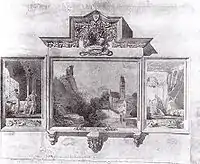August von Bayer
August von Bayer (1803-1875) was a German painter of architectural subjects


Life
Bayer was born in May 1803 into a patrician Catholic family in Rorschach.[1] He studied architecture under Weinbrenner, at Karlsruhe. In the mid-1820s he went to Munich, with the intention of pursuing a career in architecture, but soon turned to painting instead. His architectural education did, however provide him with a knowledge of construction rare amongst painters. He combined this knowledge with outstanding gifts as a colourist, which allowed him to tackle the most subtle effects of light.[1]
In the early 1840s he moved to Baden-Baden, where his work came to the attention of a wider circle of prominent admirers, including Friedrich Wilhelm IV, King of Hanover, and Queen Augusta of Prussia. He spent the winters in Karlsruhe.[1] In 1853 he was appointed him conservator of the monuments and antiquities in the Grand Duchy of Baden,[2] a post to which he brought more of an aesthetic than a scientific outlook.[1]
His last years were clouded by illness. He died in Karlsruhe on 2 February 1875.[1]
Works
Among his best works are:[2]
- The interior of the Frauenkirche at Munich.
- A portion of the Cathedral at Chur.
- The Convent of Maulbronn.
- The Organ Player (lithographed hy Fr. Hohe).
- An interior of a Cloister (lithographed by Fr. Hohe) .
There are four works by him in the Pinakothek at Munich.
See also
References
- Weech, Friedrich von (1902). "Bayer, August von". Allgemeine Deutsche Biographie. 46. Historischen Kommission bei der Bayerischen Akademie der Wissenschaften. pp. 277–8.
- Bryan 1886
Sources
 This article incorporates text from a publication now in the public domain: Bryan, Michael (1886). "Bayer, August von". In Graves, Robert Edmund (ed.). Bryan's Dictionary of Painters and Engravers (A–K). I (3rd ed.). London: George Bell & Sons.CS1 maint: ref=harv (link)
This article incorporates text from a publication now in the public domain: Bryan, Michael (1886). "Bayer, August von". In Graves, Robert Edmund (ed.). Bryan's Dictionary of Painters and Engravers (A–K). I (3rd ed.). London: George Bell & Sons.CS1 maint: ref=harv (link)